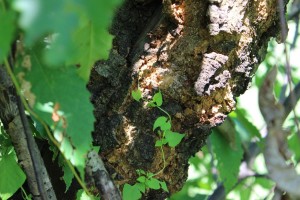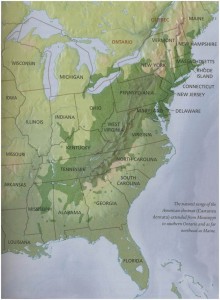MANTUA, Ohio — Bob Stehli, owner of Wintergreen Tree Farm, has had a fascination with the American chestnut tree since childhood.
After more than two decades of trial and error, he is now among a group of researchers poised to bring the formerly abundant species, or some variety of it, back to the American landscape.
“The surviving trees are so isolated that they don’t get pollinated,” Stehli said. “By the time I got this farm, I had collected seed from the last American chestnut in this area.”
Blight strikes
Perhaps the most important natural resource in the eastern United States during the nation’s founding, massive American chestnut varieties, some as much as 50 feet high and 5 feet in diameter, stretched from Maine to Mississippi.
By the turn of the 20th century, an estimated 4 billion American chestnuts, or one-quarter of the hardwood tree population, grew within this range.
Within the first half of the 20th century, however, the American chestnut became the victim of a fungus known as chestnut blight that was introduced by an Asian species of the chestnut tree.

Early efforts
In the early 1990s, Stehli began experimenting with grafting blight-susceptible American and European varieties with blight-resistant Chinese and Japanese chestnut trees, a smaller, orchard-friendly species that also produces larger chestnuts.
“What I found is that the American chestnut has no immunity at all to this blight,” Stehli said. “It’s not in its genes.”
His first orchard of 300 Dunstan chestnut trees, an American-Chinese cross developed in the 1950s from American chestnut seedlings found in Salem, Ohio, was partly frozen out in the winter of 1993. The effort of manually pollinating the trees until they were able to begin cross-pollinating on their own eventually began to pay off.
In 1997, Stehli got seedlings of “probably the best 25 (chestnut) trees in North America” from the Northern Nut Growers Association and planted an orchard of 4,425 of those seedlings — a mixed bag of pure American, Chinese, Chinese-European, Japanese-European, Japanese-American and American-European-Chinese crosses — in Hiram, Ohio.
Stehli and his Northern Nut Growers colleagues kept notes over the next decade, with an eye on discovering the best nut-producing seedlings.
“Some seed produced one good tree in 100 and with others, it was one in two,” he said. “And there was a huge amount of genetic diversity,”
In 2002, those best-of-the-best were taken to a Wintergreen orchard with good ground — dry and acidic in the case of chestnuts — in Ashland, Ohio.
“We took the best of the seedlings and planted one row of trees tested in Hiram, and another row of (experimental) seedlings,” Stehli said of the on-farm research in the Ashland orchard. “So even if the (experimental seedlings) don’t produce, we know the tested trees are bringing in some good pollen.”
Goals change
Over the past two decades, Stehli said, his focus has shifted from reintroducing the American chestnut, to establishing a high-yielding, blight-resistant “super hybrid chestnut” tree as a consumer crop
“There is a huge nostalgia connected to the American chestnut,” he said. “But I decided that trying to re-introduce the American chestnut as a forest tree is, unfortunately, a waste of time.”
He believes his American chestnut hybrids can, instead, serve a small, but viable, ethnic market for the nuts themselves.
“My thought has always been that if you really wanted to find a way to save the chestnut tree, show people that it can make money.”
While the process is a slow one, Stehli said it is possible to produce 2,000 pounds and “several thousand dollars” worth of chestnuts annually by an orchard’s seventh or eighth year.
That’s not to say that he has abandoned hope the American chestnut will someday be reintroduced to its natural habitat.
“Somebody, someday is going to find a variety that works in the wild.”

Different view
Dr. Brian C. McCarthy, an environmental and plant biology professor at Ohio University and member of the American Chestnut Foundation board of directors, may be one of those people.
The foundation has been actively trying to reintroduce the American chestnut as a forest tree since the 1980s.
“We initially crossed with a Chinese chestnut, then took those offspring and crossed them back with American seedlings,” McCarthy said. “All offspring are injected with the blight — they try to kill all the progeny. It’s called ‘directional selection’ and is sort of natural selection helped by humans.”
The result, after three generations, is a chestnut tree that is “15/16ths American,” McCarthy said.
The foundation, along with the National Wild Turkey Federation, will be test planting 750 of these seedlings Oct. 25 in the Wayne National Forest in Nelsonville, Ohio.
“We are at a landmark point now,” McCarthy said. “Our goal is to get a blight-resistant American chestnut onto the landscape that is able to survive on its own.”
Reintroducing the American chestnut as a timber tree, however, is likely generations away.
”This species used to be known as the redwood of the East,” McCarthy said. “It was used for every log cabin and most barns built in the 1800s, split rail fences, outhouses and any outdoor use, due to its weather resistance.
“And some would argue that the loss of the American chestnut led to declines in wildlife populations and may have had a direct impact on the extinction of the passenger pigeon.
“When it becomes a viable commodity again, I don’t know. I expect to be long underground by then. I’m just doing my part now.”
Correcting the past
Gary Micsky, Penn State Extension sustainable agriculture/natural resources educator in Mercer County, has worked closely with the American Chestnut Foundation and regularly holds American chestnut restoration classes.
“The question I get all the time is ‘why bother if these are going to die anyway?’ The thing is to keep the genetics alive,” Micsky said. “The American chestnut was a magnificent tree — tall, straight, fast-growing and of wonderful quality.
“And, doggone it, it is supposed to be here. How many times do we have a chance to make something right that we as humans have messed up?”
For more information on growing chestnuts in Ohio, click here.











